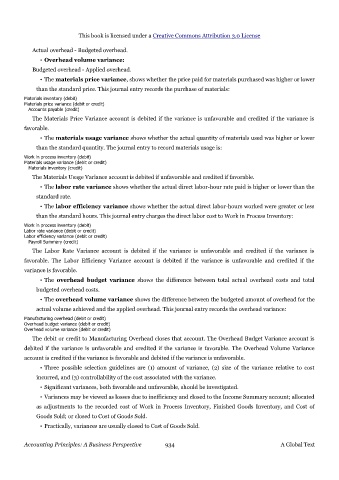Page 933 - Accounting Principles (A Business Perspective)
P. 933
This book is licensed under a Creative Commons Attribution 3.0 License
Actual overhead - Budgeted overhead.
• Overhead volume variance:
Budgeted overhead - Applied overhead.
• The materials price variance, shows whether the price paid for materials purchased was higher or lower
than the standard price. This journal entry records the purchase of materials:
Materials inventory (debit)
Materials price variance (debit or credit)
Accounts payable (credit)
The Materials Price Variance account is debited if the variance is unfavorable and credited if the variance is
favorable.
• The materials usage variance shows whether the actual quantity of materials used was higher or lower
than the standard quantity. The journal entry to record materials usage is:
Work in process inventory (debit)
Materials usage variance (debit or credit)
Materials inventory (credit)
The Materials Usage Variance account is debited if unfavorable and credited if favorable.
• The labor rate variance shows whether the actual direct labor-hour rate paid is higher or lower than the
standard rate.
• The labor efficiency variance shows whether the actual direct labor-hours worked were greater or less
than the standard hours. This journal entry charges the direct labor cost to Work in Process Inventory:
Work in process inventory (debit)
Labor rate variance (debit or credit)
Labor efficiency variance (debit or credit)
Payroll Summary (credit)
The Labor Rate Variance account is debited if the variance is unfavorable and credited if the variance is
favorable. The Labor Efficiency Variance account is debited if the variance is unfavorable and credited if the
variance is favorable.
• The overhead budget variance shows the difference between total actual overhead costs and total
budgeted overhead costs.
• The overhead volume variance shows the difference between the budgeted amount of overhead for the
actual volume achieved and the applied overhead. This journal entry records the overhead variance:
Manufacturing overhead (debit or credit)
Overhead budget variance (debit or credit)
Overhead volume variance (debit or credit)
The debit or credit to Manufacturing Overhead closes that account. The Overhead Budget Variance account is
debited if the variance is unfavorable and credited if the variance is favorable. The Overhead Volume Variance
account is credited if the variance is favorable and debited if the variance is unfavorable.
• Three possible selection guidelines are (1) amount of variance, (2) size of the variance relative to cost
incurred, and (3) controllability of the cost associated with the variance.
• Significant variances, both favorable and unfavorable, should be investigated.
• Variances may be viewed as losses due to inefficiency and closed to the Income Summary account; allocated
as adjustments to the recorded cost of Work in Process Inventory, Finished Goods Inventory, and Cost of
Goods Sold; or closed to Cost of Goods Sold.
• Practically, variances are usually closed to Cost of Goods Sold.
Accounting Principles: A Business Perspective 934 A Global Text

